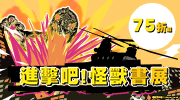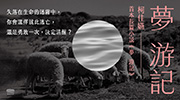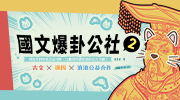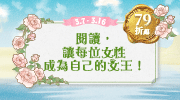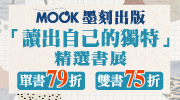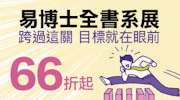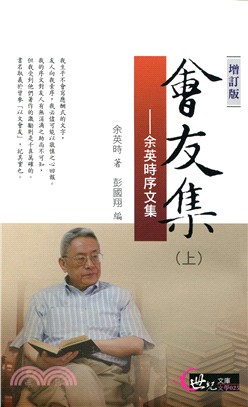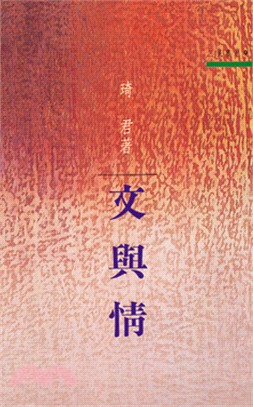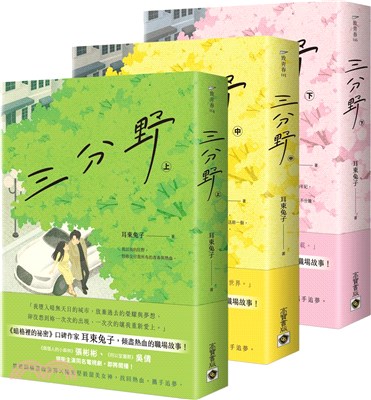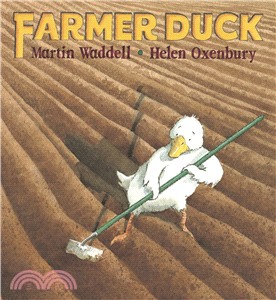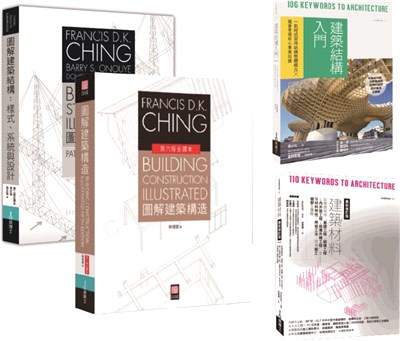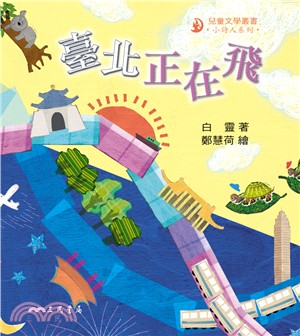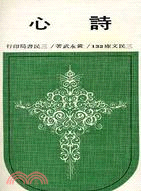我和高溫超導:大洋兩岸人生路(國際英文版)
商品資訊
系列名:名人自傳
ISBN13:9781647842079
替代書名:High Temperature Superconductor and Me: A Scientist's Journey Across Oceans
出版社:漢世紀數位文化EHGBooks
作者:蒙如玲
譯者:WILLIAM NISBETT; WEI LI
出版日:2023/06/01
裝訂/頁數:平裝/240頁
規格:22.9cm*15.2cm*2cm (高/寬/厚)
重量:400克
版次:初版
定價
:NT$ 750 元優惠價
:79 折 593 元
無庫存,下單後進貨(採購期約4~10個工作天)
下單可得紅利積點:17 點
商品簡介
作者簡介
序
目次
書摘/試閱
商品簡介
●圖書簡介●
蒙如玲是休士頓大學德州超導中心的傑出科學家。本書以英文自傳體的形式描述了她色彩斑斕的一生,並以高溫超導研究為主線,前後貫通,一氣呵成。這本書分為兩部分,第一部分紀錄了80年代和90年代,當全世界許多科學家都在競相尋找高溫的超導體,作者在那場激烈競爭的歷史浪潮中,引領潮流的精彩畫面。第二部分則生動地記錄了作者對生命價值的不懈追求,回顧了她從年輕女孩到受人尊敬的科學家的心路歷程。本書內容豐富,細節引人入勝,非常值得一讀。
Ruling Meng, the author, is an exceptional scientist from Texas Center for Superconductivity at University of Houston. This autobiography describes her colorful life in detail, with high-temperature superconductivity research as the through line from beginning to end. The book is divided in two parts. The first illustrates the fierce competition in high-temperature superconducting material research during the 80s and 90s, when many scientists worldwide were racing to find the hottest superconductors. Meng was a famous and important participant in this historic competition. The second part vividly records the author's tireless pursuit of the value of life, recalling her journey from young girl to respected scientist. Rich in content and fascinating detail, this book is well worth reading.
◆Acknowledgement◆
I am most indebted to my dear friend, Jianjun Zeng, who encouraged me to embark on the adventure of writing a book in Chinese and then in English. She always had time to talk through a point, an idea, or the form and content. Without her numerous hours of editing, this book would not be possible.
I am also indebted to my dear friend, Zihong Zhang, who as a copy editor did many iterations of the content and form to make them fit for publication. This book would not be possible without his tremendous contributions.
My thanks also go to Professor David Ross for his meticulous proof reading of the English texts and to Mr. William Nisbett and Professor Wei Li for their translations.
My family has been part of the journey from the beginning. My dedication to research coincided with the formative years of my son and my daughter. I regret that I did not spend enough time with them when I was working long hours at the lab. My life story would be different without their understanding and support.
Ruling Meng
蒙如玲是休士頓大學德州超導中心的傑出科學家。本書以英文自傳體的形式描述了她色彩斑斕的一生,並以高溫超導研究為主線,前後貫通,一氣呵成。這本書分為兩部分,第一部分紀錄了80年代和90年代,當全世界許多科學家都在競相尋找高溫的超導體,作者在那場激烈競爭的歷史浪潮中,引領潮流的精彩畫面。第二部分則生動地記錄了作者對生命價值的不懈追求,回顧了她從年輕女孩到受人尊敬的科學家的心路歷程。本書內容豐富,細節引人入勝,非常值得一讀。
Ruling Meng, the author, is an exceptional scientist from Texas Center for Superconductivity at University of Houston. This autobiography describes her colorful life in detail, with high-temperature superconductivity research as the through line from beginning to end. The book is divided in two parts. The first illustrates the fierce competition in high-temperature superconducting material research during the 80s and 90s, when many scientists worldwide were racing to find the hottest superconductors. Meng was a famous and important participant in this historic competition. The second part vividly records the author's tireless pursuit of the value of life, recalling her journey from young girl to respected scientist. Rich in content and fascinating detail, this book is well worth reading.
◆Acknowledgement◆
I am most indebted to my dear friend, Jianjun Zeng, who encouraged me to embark on the adventure of writing a book in Chinese and then in English. She always had time to talk through a point, an idea, or the form and content. Without her numerous hours of editing, this book would not be possible.
I am also indebted to my dear friend, Zihong Zhang, who as a copy editor did many iterations of the content and form to make them fit for publication. This book would not be possible without his tremendous contributions.
My thanks also go to Professor David Ross for his meticulous proof reading of the English texts and to Mr. William Nisbett and Professor Wei Li for their translations.
My family has been part of the journey from the beginning. My dedication to research coincided with the formative years of my son and my daughter. I regret that I did not spend enough time with them when I was working long hours at the lab. My life story would be different without their understanding and support.
Ruling Meng
作者簡介
蒙如玲,1958年畢業於中南礦冶學院(現中南工大),在中國科學院礦冶研究所和物理研究所從事材料研發工作。1979年受朱經武教授邀請,到美國休士頓大學進行超導材料研究,是1986年發現釔鋇銅氧高溫超導體的主要貢獻者之一,2000年被美國科學資訊研究所從50萬名科學論文作者中,評選為科研論文引用率最高的1000名科學家之一。
Ruling Meng, the author, was graduated from Zhongnan Institute of Mining and Metallurgy (now Central South University of Technology) in 1958. She engaged in material research and development at the Institute of Mining and Metallurgy and the Institute of Physics from Chinese Academy of Sciences. In 1979, she was invited by Professor C.W. Paul Chu of University of Houston to conduct research on superconducting materials. She was one of the main contributors to the discovery of yttrium-barium-copper-oxygen high-temperature superconductors in 1986. In 2000, she was selected by the American Institute of Scientific Information as one of the 1,000 scientists with the highest citation rate of scientific research papers among 500,000 scientific paper authors.
Ruling Meng, the author, was graduated from Zhongnan Institute of Mining and Metallurgy (now Central South University of Technology) in 1958. She engaged in material research and development at the Institute of Mining and Metallurgy and the Institute of Physics from Chinese Academy of Sciences. In 1979, she was invited by Professor C.W. Paul Chu of University of Houston to conduct research on superconducting materials. She was one of the main contributors to the discovery of yttrium-barium-copper-oxygen high-temperature superconductors in 1986. In 2000, she was selected by the American Institute of Scientific Information as one of the 1,000 scientists with the highest citation rate of scientific research papers among 500,000 scientific paper authors.
序
◆Editorial Note◆
It was the fall of 1993 when I first met Ms. Meng, Ruling at the annual meeting of the Chinese Association of Professionals in Science and Technology (CAPST) in Houston. As the then President of CAPST, she was delivering a report to the members on the work of the previous year. From 2000 to 2001, when my family was going through a difficult time, she extended a timely helping hand to me.
But what really inspired me to write about her was what I learned in 2004, when Ruling shared with me what had happened in the scientific research field of high-temperature superconductivity between the end of 1986 and the beginning of 1987. In a “Contest of the Century,” researchers in physical and material sciences from all over the world broke the high-temperature superconductivity records, one after another. At that time, surrounded by thousands of outstanding male researchers, there were only a few female professionals in this research field, mostly women of Chinese origin, Ruling was the most senior one among them. Moreover, she was the only Chinese scholar who had received a college degree from a university in China and started her career in a research institute in China. She came to the United States when she was over forty. With years of solid academic attainments and unimaginable hard work, she became a world-class materials scientist within a few years, and she was respected by her colleagues at home and abroad. From 1981 to 1997, she was among the 500,000 authors of scientific papers in the world and became one of the 1,000 most-cited published scientists and the first female author in the field of superconducting materials. In addition to admiration for her, I was extremely curious about such a friend who has stories.
In 2005, I had more than 20 hours of in-depth interviews with Meng and wrote a 12,000-word article in Chinese based on our discussions, later edited by her and partially published on a local website. But that was far from what we had envisioned: to provide a faithful “snapshot” of a specific moment in the history of physical and material sciences. Both of us were busy working full-time then, and I also needed time to digest the many new concepts in superconductivity research and to learn the unfamiliar terminology in material sciences involved in the article. My goal was to organize the wonderful moments that Ruling wanted to share with the world into a coherent story that non-professional readers can understand and want to read. For this reason, our writing plan was put on hold until 2017, after I officially retired and after Ruling’s solo amateur artist exhibition closed. In May 2018, I received the first batch of drafts sent by Ruling via email, and we started our hard work together. In the following three years, we had nearly a hundred discussions and debates, and many new chapters were added after more than a dozen revisions. The first manuscript in Chinese was completed by the end of 2020.
Thanks to the joint efforts of many friends, the Chinese edition of this book was published in April, 2021. Some of Ruling’s friends reviewed the book, making hundreds of comments and modifications, ranging from the main event timeline and participant information to the Chinese translation of English scientific and technological terms and names. Dr. Zihong Zhang, our common friend, was put in charge of the layout and illustrations of the book. Because Ruling and I were inexperienced in manuscript writing and editing, we frequently revised the manuscript after typesetting. Zihong not only made and updated the plates in a timely manner more than ten times, but also made suggestions for selecting content, handling appropriate expression of concepts and emotions, as well as finalizing the English manuscript. Ms. Mei Li, who was the last to join the editorial board for the Chinese version, was expected to proofread words and sentences using her experience working for her church in recent years. However, after carefully reviewing the content of the manuscript, she proposed to divide the technical and social contents of the book into two parts, one focusing on scientific issues, and the other on sociological issues. She also made specific suggestions to highlight the theme and special features of the book.
Some mistakes in the Chinese version have been corrected in the English version. My sincere thanks go to the many friends who made their unique contributions to the English version of this book, including but not limited to the following: Mr. William Nisbett, with a BS degree in Chinese Language and a MS degree in Physics from the University of Houston, participated in the English translation of the second part of the book. Working for a high-tech company then, he used his spare time to finish the translation in just two months, thanks to his fine understanding of the Chinese language and culture. Dr. Wei, Li, a retired professor of English Language and Literature from Lone Star College, translated the most challenging chapters of this book due to their scientific and technological difficulty. He also reviewed and revised the other chapters’ English translation to ensure the English translation conveys the original ideas of the Chinese author faithfully. Mr. David Ross, a professor of English and English as a Second Language at Houston Community College, worked as the English editor and proofreader of the entire book. His professional standard and dedication guaranteed smooth reading and easy comprehension by English-speaking readers. Finally, Danqing Bei, David Ross’s wife, helped in translating all the captions of figures and photos.
In addition to the editorial committee, friends who provided selfless help and enthusiastic encouragement for Chinese and English versions of this book include: Miss Peiheng Zhu, who proofread all chapters of the Chinese version word by word; Dr. Jieqiang Guo, who revised the first draft of two chapters in Chinese; Meng’s colleagues far away in China, Mr. Nengzhong Ye and Mr. Ruxing Wu, as well as friends in Houston, Drs. Jianguang Wang and Jianjun Jiang, took time to read the entire book or relevant chapters in Chinese and provided valuable feedback. Professor Sharron Wen, Chair of the Chinese Language program of the Department of Languages at the University of Houston, gave her full support by recommending her best student in Chinese Language, Mr. Nisbett, to join the translation work.
I would like to quote a sentence from the book to end my introduction:
I hope that in the year 2100, when our descendants open the ‘National Millennium Time Capsule’ in the ‘National Museum of American History’, and take out those five-centimeter diameter Yttrium-Barium-Copper-Oxide high temperature superconductors, they will be able to recall the stories this book tells and the contributions made from so many “heroes behind the scenes”.
Jianjun Zeng(Ph D, Geology)
Sept. 15, 2022 in Houston
It was the fall of 1993 when I first met Ms. Meng, Ruling at the annual meeting of the Chinese Association of Professionals in Science and Technology (CAPST) in Houston. As the then President of CAPST, she was delivering a report to the members on the work of the previous year. From 2000 to 2001, when my family was going through a difficult time, she extended a timely helping hand to me.
But what really inspired me to write about her was what I learned in 2004, when Ruling shared with me what had happened in the scientific research field of high-temperature superconductivity between the end of 1986 and the beginning of 1987. In a “Contest of the Century,” researchers in physical and material sciences from all over the world broke the high-temperature superconductivity records, one after another. At that time, surrounded by thousands of outstanding male researchers, there were only a few female professionals in this research field, mostly women of Chinese origin, Ruling was the most senior one among them. Moreover, she was the only Chinese scholar who had received a college degree from a university in China and started her career in a research institute in China. She came to the United States when she was over forty. With years of solid academic attainments and unimaginable hard work, she became a world-class materials scientist within a few years, and she was respected by her colleagues at home and abroad. From 1981 to 1997, she was among the 500,000 authors of scientific papers in the world and became one of the 1,000 most-cited published scientists and the first female author in the field of superconducting materials. In addition to admiration for her, I was extremely curious about such a friend who has stories.
In 2005, I had more than 20 hours of in-depth interviews with Meng and wrote a 12,000-word article in Chinese based on our discussions, later edited by her and partially published on a local website. But that was far from what we had envisioned: to provide a faithful “snapshot” of a specific moment in the history of physical and material sciences. Both of us were busy working full-time then, and I also needed time to digest the many new concepts in superconductivity research and to learn the unfamiliar terminology in material sciences involved in the article. My goal was to organize the wonderful moments that Ruling wanted to share with the world into a coherent story that non-professional readers can understand and want to read. For this reason, our writing plan was put on hold until 2017, after I officially retired and after Ruling’s solo amateur artist exhibition closed. In May 2018, I received the first batch of drafts sent by Ruling via email, and we started our hard work together. In the following three years, we had nearly a hundred discussions and debates, and many new chapters were added after more than a dozen revisions. The first manuscript in Chinese was completed by the end of 2020.
Thanks to the joint efforts of many friends, the Chinese edition of this book was published in April, 2021. Some of Ruling’s friends reviewed the book, making hundreds of comments and modifications, ranging from the main event timeline and participant information to the Chinese translation of English scientific and technological terms and names. Dr. Zihong Zhang, our common friend, was put in charge of the layout and illustrations of the book. Because Ruling and I were inexperienced in manuscript writing and editing, we frequently revised the manuscript after typesetting. Zihong not only made and updated the plates in a timely manner more than ten times, but also made suggestions for selecting content, handling appropriate expression of concepts and emotions, as well as finalizing the English manuscript. Ms. Mei Li, who was the last to join the editorial board for the Chinese version, was expected to proofread words and sentences using her experience working for her church in recent years. However, after carefully reviewing the content of the manuscript, she proposed to divide the technical and social contents of the book into two parts, one focusing on scientific issues, and the other on sociological issues. She also made specific suggestions to highlight the theme and special features of the book.
Some mistakes in the Chinese version have been corrected in the English version. My sincere thanks go to the many friends who made their unique contributions to the English version of this book, including but not limited to the following: Mr. William Nisbett, with a BS degree in Chinese Language and a MS degree in Physics from the University of Houston, participated in the English translation of the second part of the book. Working for a high-tech company then, he used his spare time to finish the translation in just two months, thanks to his fine understanding of the Chinese language and culture. Dr. Wei, Li, a retired professor of English Language and Literature from Lone Star College, translated the most challenging chapters of this book due to their scientific and technological difficulty. He also reviewed and revised the other chapters’ English translation to ensure the English translation conveys the original ideas of the Chinese author faithfully. Mr. David Ross, a professor of English and English as a Second Language at Houston Community College, worked as the English editor and proofreader of the entire book. His professional standard and dedication guaranteed smooth reading and easy comprehension by English-speaking readers. Finally, Danqing Bei, David Ross’s wife, helped in translating all the captions of figures and photos.
In addition to the editorial committee, friends who provided selfless help and enthusiastic encouragement for Chinese and English versions of this book include: Miss Peiheng Zhu, who proofread all chapters of the Chinese version word by word; Dr. Jieqiang Guo, who revised the first draft of two chapters in Chinese; Meng’s colleagues far away in China, Mr. Nengzhong Ye and Mr. Ruxing Wu, as well as friends in Houston, Drs. Jianguang Wang and Jianjun Jiang, took time to read the entire book or relevant chapters in Chinese and provided valuable feedback. Professor Sharron Wen, Chair of the Chinese Language program of the Department of Languages at the University of Houston, gave her full support by recommending her best student in Chinese Language, Mr. Nisbett, to join the translation work.
I would like to quote a sentence from the book to end my introduction:
I hope that in the year 2100, when our descendants open the ‘National Millennium Time Capsule’ in the ‘National Museum of American History’, and take out those five-centimeter diameter Yttrium-Barium-Copper-Oxide high temperature superconductors, they will be able to recall the stories this book tells and the contributions made from so many “heroes behind the scenes”.
Jianjun Zeng(Ph D, Geology)
Sept. 15, 2022 in Houston
目次
Contents
Acknowledgement
Editorial Note
List of Figures
List of Tables
▲Part I: High Temperature Superconductors and Me
Prologue
Chapter 1: I Changed my Career Twice
First foray into superconducting materials
Returning to the research “National Team”
Building a thin film lab
A surprise invitation
Chapter 2: My Promise at the Starting Line
Starting from scratch
First victory
No pain no gain
Chapter 3: Days of Challenging 97K
Returning to Houston
Proving the 35K oxide superconductor
Superconducting transition at 52.5K under pressure
Materials Research Society Annual Meeting in Boston
Optimizing process to make superconductors
“Element substitution”
Mystery of yttrium
A news conference
Identifying the structure of the new high temperature superconductor
Cranking on all cylinders: discovering a series of rare earth high Tc superconductors
American Physical Society (APS) Annual Meeting
Notes
Chapter 4: New Frontiers
The emergence of new superconductor series
Finding the synthesis mechanism for Hg-base superconductors
The first defect-free C60 single crystal
Applications of high temperature superconductors
Large dimension bulk and rod superconductors
Fabrication of mercury superconductor tape
Fabrication of bismuth superconducting tape
Notes
Chapter 5 Inside and Outside the Media Halo
“Changing a bird shotgun for a cannon”
“Heroes behind the scenes”
The “Little United Nations” of the Superconductivity Center
“The fame of a general is built upon the ashes of millions of dead soldiers”
Chapter 6 “Our” Patent
He applied for a patent for “Us”
An eighteen-year-old mystery
Requesting internal mediation
Ripple effects?
Lawyer’s evidence
Nine years of difficult road of “rights protection”
Who is the co-inventor of the patent?
Thoughts on the “Time limitations of legal action”
Who’s to judge?
Photos
▲Part 2: A Life on Two Sides of the Ocean
Prologue
Chapter 1: Growing up and Schooling
My father and mother
A tomboy hiding from the Japanese
A young girl’s dreams of becoming a writer
From a young Miss to a country girl
Toward becoming a STEM girl
University life
The great calamity of the Cultural Revolution
Notes
Chapter 2: My Forty-Year American Journey
Flying to the new continent
My Chinese colleagues from the Physics Department of UH
The helping hands of overseas Chinese
American friends
The shadow of the FBI
Chapter 3: Different Worlds
The rigor of the Germans
The tolerance and taste of the French
The pragmatism of the Japanese
Italy’s “famous brand”
Chapter 4: The Wide-Open World Outside of the Lab
Serving the community
Giving back to my Alma Mater
Starting an offshore wind power plant
Promoting the application of high-temperature superconductors
Singing, drawing, and fundraising for the scientific research innovation award
Acknowledgement
Editorial Note
List of Figures
List of Tables
▲Part I: High Temperature Superconductors and Me
Prologue
Chapter 1: I Changed my Career Twice
First foray into superconducting materials
Returning to the research “National Team”
Building a thin film lab
A surprise invitation
Chapter 2: My Promise at the Starting Line
Starting from scratch
First victory
No pain no gain
Chapter 3: Days of Challenging 97K
Returning to Houston
Proving the 35K oxide superconductor
Superconducting transition at 52.5K under pressure
Materials Research Society Annual Meeting in Boston
Optimizing process to make superconductors
“Element substitution”
Mystery of yttrium
A news conference
Identifying the structure of the new high temperature superconductor
Cranking on all cylinders: discovering a series of rare earth high Tc superconductors
American Physical Society (APS) Annual Meeting
Notes
Chapter 4: New Frontiers
The emergence of new superconductor series
Finding the synthesis mechanism for Hg-base superconductors
The first defect-free C60 single crystal
Applications of high temperature superconductors
Large dimension bulk and rod superconductors
Fabrication of mercury superconductor tape
Fabrication of bismuth superconducting tape
Notes
Chapter 5 Inside and Outside the Media Halo
“Changing a bird shotgun for a cannon”
“Heroes behind the scenes”
The “Little United Nations” of the Superconductivity Center
“The fame of a general is built upon the ashes of millions of dead soldiers”
Chapter 6 “Our” Patent
He applied for a patent for “Us”
An eighteen-year-old mystery
Requesting internal mediation
Ripple effects?
Lawyer’s evidence
Nine years of difficult road of “rights protection”
Who is the co-inventor of the patent?
Thoughts on the “Time limitations of legal action”
Who’s to judge?
Photos
▲Part 2: A Life on Two Sides of the Ocean
Prologue
Chapter 1: Growing up and Schooling
My father and mother
A tomboy hiding from the Japanese
A young girl’s dreams of becoming a writer
From a young Miss to a country girl
Toward becoming a STEM girl
University life
The great calamity of the Cultural Revolution
Notes
Chapter 2: My Forty-Year American Journey
Flying to the new continent
My Chinese colleagues from the Physics Department of UH
The helping hands of overseas Chinese
American friends
The shadow of the FBI
Chapter 3: Different Worlds
The rigor of the Germans
The tolerance and taste of the French
The pragmatism of the Japanese
Italy’s “famous brand”
Chapter 4: The Wide-Open World Outside of the Lab
Serving the community
Giving back to my Alma Mater
Starting an offshore wind power plant
Promoting the application of high-temperature superconductors
Singing, drawing, and fundraising for the scientific research innovation award
書摘/試閱
◎No pain no gain◎
In the fall of 1981, Professor Ernst Bucher, chairman of the Physics Department at the University of Konstanz in Germany, visited our lab at the University of Houston. Professor Bucher was both an excellent physicist and material scientist. In his early career at Bell Lab, he was the first to observe a new type of superconductor called heavy fermion superconductor. For this, his picture hangs on the wall in Bell Labs’ hallway. Back when Dr. Chu was at Bell Labs, he and Bucher were colleagues. Actually, Dr. Chu’s first paper at Bell Labs had Bucher as a co-author.
During Dr. Bucher’s visit, I consulted with him on some questions regarding superconducting thin film and single crystal growth. Whenever I asked about a particular superconductor, he would take out a small but thick notebook from his shirt pocket; then he would proceed to tell me everything about the material, how to prep the material and ways to make it. It was fascinating listening to such an amazing person. No wonder Dr. Chu highly respected him. What intrigued me the most was that little notebook. It was like a little library full of information. I wished that I could get my hands on it and study it as much as I wanted.
Dr. Chu had wanted to grow different kinds of single crystals. He came up with a lengthy list, including more than twenty possible superconductors. Unfortunately, Dr. Bucher could not stay in Houston for too long. Furthermore, our still limited equipment in the materials lab was clearly insufficient if we wanted to grow more than twenty crystals. Instead, Dr. Bucher suggested that I spend several months in his physics lab to learn and grow the twenty-plus single crystals. Excited about the opportunity, I immediately wrote to the Institute of Physics (IP) of the Chinese Academy of Science (CAS). They were quite open about my request and agreed to let me spend three months in Germany before returning to the Institute. In order to make it possible for me to pay for my trip expenses, Dr. Bucher very generously offered to pay me a salary equivalent to that of an associate professor in Germany.
On the weekend of Halloween in 1981, my plane landed at the small town of Konstanz by Lake Borden in Southern Germany. I walked out of the airport with my simple luggage. A Chinese man was waiting for me. He shook my hand and introduced himself as a visiting scholar from Shanghai, China. Per Professor Bucher’s request, he was there to pick me up. We took a public metro bus and arrived at the University of Konstanz. Walking into a one-room efficiency apartment, I found some green vegetables, some rice, and a small pot on the kitchen table. The young man kindly explained to me that originally the professor asked him to get a bunch of flowers. But he thought that since it was the weekend, shops were all closed. He worried that I would go hungry, so instead of buying flowers, he took the initiative to use the money to buy rice and vegetables. I was really moved by my fellow countryman since we mutually understood the importance of “seven things” (Chinese saying: firewood, rice, cooking oil, salt, soy sauce, vinegar, and tea, daily necessities), while Germans love flowers. Coming from the hot and humid city of Houston, I was totally unprepared for the snowy German town in the northern hemisphere. Other than a wool overcoat, I had no other proper clothes or shoes to keep me warm. But I could not wait to take care of warm clothes. Instead, right after the holiday I started my work in the laboratory.
The University of Konstanz broke the mold of the traditional university divisions into colleges and departments. Instead, it was known to have many multi-cross-disciplinary research institutes. In every research group, a professor would lead a number of researchers. In Professor Bucher’s group, there were two senior researchers, a dozen graduate students, and a master technician (Photo 17). My first day there was a huge eye-opener. The labs were well equipped with all sorts of high vacuum instruments. Enthusiastically I ran from the first floor to the second floor, then to the third floor, looking at room after room full of various high vacuum systems, thin film devices and single crystal growers. I saw the world’s only ultra-high vacuum tungsten furnace designed and built by the lab, capable of reaching 2,500°C. There were machining devices such as lathes installed inside the vacuum system, capable of processing rare earth materials that would easily oxidize in air. There was an enormous machine by a wall, used to make large glass instruments. Later I would use this machine to make a high vacuum system.
The technician in Dr. Bucher’s lab was truly a versatile and capable master, with superb technical skills and knowledge in all sorts of subjects. He could design equipment and operate all the instruments in the lab. He taught me how to control different ultra-high vacuum systems to grow thin films and single crystals, let me understand and try different ways to grow crystals. We arranged the twenty-two single crystals listed by Dr. Chu into several devices, using different techniques to grow these crystals. During that period, I worked twelve hours nearly every day, growing 2- and 3-dimensional single crystals and thin films. Using vapor deposition, I grew 2-dimensional single crystals that looked like butterfly wings. With Arc Melt Drawing, I grew binary and ternary alloy single crystals. It was simply exciting because I did not know if there were laboratories anywhere else in the world that were as well-equipped and advanced as Dr. Bucher’s lab.
I also eagerly anticipated the routine weekly research meetings. For the benefit of a guest who spoke not a word of German, all talks and discussions were in English. Researchers took turns describing project progress, from big research topic plans, to small steps in experimental design, even to such level of small details such as how temperature and gas atmosphere were controlled. After each report, people would comment or sometimes raise sharp disagreement. The breadth of topics covered widely different specialty fields. This greatly expanded my knowledge in these areas.
In that laboratory, I truly experienced German scientists’ seriousness and meticulousness, as well as their technical rigor. From the design of scientific equipment to such trivial things as the mechanism to open and close a window, much emphasis was placed on quality and practicality. Taking an ordinary window for example, it was designed to suit Germany’s wintry conditions, guaranteeing proper air circulation without leaking. I thought, that was why with a population of merely eighty million, Germany possessed over twenty-three hundred famous brands in the world. A simple cooking pan could last over a hundred years. I learned that their lab instruments were calibrated regularly while some were checked randomly. All rare earth materials were handled inside vacuum. Even the surrounding environment outside the vacuum was carefully examined. Why such strict control? There were reasons, as illustrated by an interesting event while I was there.
A female researcher in the lab was growing a kind of single crystal. She failed several times, but could not find any causes. With the New Year holiday coming, she planned to go skiing in the Alps in Switzerland. So she programmed the equipment according to the designed experiment, started it running and went off skiing. When she came back from vacation, to her great surprise, this time the single crystal grew perfectly. For the life of her she could not figure out why, because all the experimental conditions and procedures were identical to those used in prior failed experiments. What had changed? After much thinking, a careful analysis was carried out on the finished product. It finally became clear: there were some “impurities” inside the grown single crystal that had not been there in prior samples. People’s gazes finally shifted to a cute little metallic trinket. This little piece became the “suspect”. Apparently, right before her vacation, she absentmindedly hung the piece on the top of the furnace. In two weeks, the little metallic piece got heated up and released trace amounts of elements, some of which apparently found their way into the reaction furnace. As luck would have it, these trace impurities catalytically contributed to crystal growth.
Germans did not work on Sundays because God said Sunday should be a day of worship and rest. Even the people mowing grass in yards were absent. This however proved to be quite convenient for an “atheist” like me. So every Sunday, I would take advantage of the absence of my German colleagues, and operate different equipment in labs all over the three floors. By Christmas, as a huge family holiday, people were spending time with family at home. Pedestrians were scarce in the streets of the little town. This was in complete contrast with Chinese holiday traditions when streets would always be full of revelers. During the holidays, I did not go sight-seeing or window-shopping. Instead, I buried my head deeply in the single crystal growth experiments. I stipulated that I would divide my days into morning, afternoon and evening, three time-slots. Running from one piece of equipment to another, from one laboratory to another, inside an otherwise vacant building for three days, I did not utter a single word, since there was no one else there.
All the time I was there, draped in the thin black wool coat I brought from China, wearing a pair of thin light shoes, I would drag myself through foot-deep snow, trekking between my student apartment and the lab. The whole day my shoes were wet. Back in my dorm at night, I put my wet shoes on the radiator to dry, for wearing next morning. Several times while grocery shopping, I saw various styles of leather boots and I longed to buy a pair to keep my feet warm. But I could not because I needed to save money for the returning airfare to China. When the weather was nice, I would take a stroll by the river. Seeing many wild ducks swimming in the icy cold river with their bare yellow feet, I wondered whether their feet were cold. The ducks reminded me of a story I heard in China about starving people hunting wild ducks during the Great Famine years. I wondered that if this were in China, in those days the wild ducks might become tasty treats on people’s dinner tables. But these wild ducks were protected. I heard that there was a thick layer of wild duck droppings on the riverbed of the beautiful River Rhine. From wild ducks, my thought drifted to the famine years when I was a young girl. I asked myself whether I should be satisfied by now.
Before the end of my three months visit, I had successfully grown all the single crystals on Dr. Chu’s list, including CeSb, CeAs, CeBi, ZrZn2, Eu1.2Mo6S8, a total of twenty-two single crystals. I divided each type of crystal into two parts. I mailed half of the crystals to Dr. Chu in the U.S., and the other half I prepared to bring with me back to IPCAS. After receiving these single crystals, Dr. Chu was pleasantly surprised. He did not expect me to grow so many single crystals in such a short time. He then expressed his desire for me to return to his University of Houston lab directly from Germany. This way we could make more materials to supply his graduate students for their thesis researches. However, I did have an agreement with IPCAS. I was supposed to return after two years at UH. I could not breach my contract. So I considerately declined his invitation. Even though I did not return to UH in person, the crystals that I mailed did provide sufficient research materials to his graduate students. For the next five or six years, Pei-Herng Hor and other students all used the crystals CeSb, CeAs, CeBi, ZrZn2, and Eu1.2 Mo6S8 in their thesis research [12] [13] [14].
There was another reason for my decision to return straight to China from Germany: in the last couple of weeks in Germany, I had become sick, perhaps due to overwork, or because I was unaccustomed to the environment, or both. The trouble was I had no medical insurance. After socking away the airfare money for my China trip, not much was left. I certainly could not afford the expensive medical insurance at the associate professor level. But because of my “associate professor” status, I could not purchase the cheap student medical insurance, either. My income was certainly not enough to pay for any medical expenses. Consequently, I had to hide my sickness to avoid any treatment and ended up dragging a little ailment into a major illness. Several times during the single crystal growth experiment, I was so weak that I could not even open a valve on top of an oxygen cylinder. When it was bad, I could not muster enough strength to climb stairs. I worried that if this dragged out any longer, I might die in a foreign country far away from my homeland. I urgently and desperately needed to return to my familiar warm home for treatment and rest.
By January of 1982, I packed up the other half of the single crystals, said farewell to Professor Bucher’s laboratory and returned to IPCAS. The three months of my stay in Germany turned out to be the most productive period of my career: I gained the most knowledge, accumulated the most technical experiences that greatly enhanced my skills, competence, and confidence. It left a deep and colorful impression in my professional career in materials research. It was in Professor Bucher’s lab where I not only came in touch with but also gained the skills to operate the world’s leading materials research equipment. The skills and know-how I gained in successfully synthesizing materials for low temperature physics experiments gave me the confidence to stand shoulder to shoulder with the world’s leading superconducting material scientists. If, before my 1979 trip to the U.S., due to the lack of scientific exchange between the U.S. and China, I had worried that my knowledge and skills might disappoint Dr. Chu, then by this time I could confidently tell Dr. Chu, or any other fellow scientist, that you could not find a second material scientist just like me: formally trained in the 1950s in China, primed in a first class national laboratory in IPCAS, further edified in the world’s most advanced materials research laboratory in Germany. A hard-working researcher full of knowledge and skills on top of impeccable work ethic, I was full of self-confidence and pride. Only five years later, in the world’s biggest superconductor race, my confidence and pride would be confirmed through the outstanding performance of our lab in University of Houston, which caught the attention of the world.
In the fall of 1981, Professor Ernst Bucher, chairman of the Physics Department at the University of Konstanz in Germany, visited our lab at the University of Houston. Professor Bucher was both an excellent physicist and material scientist. In his early career at Bell Lab, he was the first to observe a new type of superconductor called heavy fermion superconductor. For this, his picture hangs on the wall in Bell Labs’ hallway. Back when Dr. Chu was at Bell Labs, he and Bucher were colleagues. Actually, Dr. Chu’s first paper at Bell Labs had Bucher as a co-author.
During Dr. Bucher’s visit, I consulted with him on some questions regarding superconducting thin film and single crystal growth. Whenever I asked about a particular superconductor, he would take out a small but thick notebook from his shirt pocket; then he would proceed to tell me everything about the material, how to prep the material and ways to make it. It was fascinating listening to such an amazing person. No wonder Dr. Chu highly respected him. What intrigued me the most was that little notebook. It was like a little library full of information. I wished that I could get my hands on it and study it as much as I wanted.
Dr. Chu had wanted to grow different kinds of single crystals. He came up with a lengthy list, including more than twenty possible superconductors. Unfortunately, Dr. Bucher could not stay in Houston for too long. Furthermore, our still limited equipment in the materials lab was clearly insufficient if we wanted to grow more than twenty crystals. Instead, Dr. Bucher suggested that I spend several months in his physics lab to learn and grow the twenty-plus single crystals. Excited about the opportunity, I immediately wrote to the Institute of Physics (IP) of the Chinese Academy of Science (CAS). They were quite open about my request and agreed to let me spend three months in Germany before returning to the Institute. In order to make it possible for me to pay for my trip expenses, Dr. Bucher very generously offered to pay me a salary equivalent to that of an associate professor in Germany.
On the weekend of Halloween in 1981, my plane landed at the small town of Konstanz by Lake Borden in Southern Germany. I walked out of the airport with my simple luggage. A Chinese man was waiting for me. He shook my hand and introduced himself as a visiting scholar from Shanghai, China. Per Professor Bucher’s request, he was there to pick me up. We took a public metro bus and arrived at the University of Konstanz. Walking into a one-room efficiency apartment, I found some green vegetables, some rice, and a small pot on the kitchen table. The young man kindly explained to me that originally the professor asked him to get a bunch of flowers. But he thought that since it was the weekend, shops were all closed. He worried that I would go hungry, so instead of buying flowers, he took the initiative to use the money to buy rice and vegetables. I was really moved by my fellow countryman since we mutually understood the importance of “seven things” (Chinese saying: firewood, rice, cooking oil, salt, soy sauce, vinegar, and tea, daily necessities), while Germans love flowers. Coming from the hot and humid city of Houston, I was totally unprepared for the snowy German town in the northern hemisphere. Other than a wool overcoat, I had no other proper clothes or shoes to keep me warm. But I could not wait to take care of warm clothes. Instead, right after the holiday I started my work in the laboratory.
The University of Konstanz broke the mold of the traditional university divisions into colleges and departments. Instead, it was known to have many multi-cross-disciplinary research institutes. In every research group, a professor would lead a number of researchers. In Professor Bucher’s group, there were two senior researchers, a dozen graduate students, and a master technician (Photo 17). My first day there was a huge eye-opener. The labs were well equipped with all sorts of high vacuum instruments. Enthusiastically I ran from the first floor to the second floor, then to the third floor, looking at room after room full of various high vacuum systems, thin film devices and single crystal growers. I saw the world’s only ultra-high vacuum tungsten furnace designed and built by the lab, capable of reaching 2,500°C. There were machining devices such as lathes installed inside the vacuum system, capable of processing rare earth materials that would easily oxidize in air. There was an enormous machine by a wall, used to make large glass instruments. Later I would use this machine to make a high vacuum system.
The technician in Dr. Bucher’s lab was truly a versatile and capable master, with superb technical skills and knowledge in all sorts of subjects. He could design equipment and operate all the instruments in the lab. He taught me how to control different ultra-high vacuum systems to grow thin films and single crystals, let me understand and try different ways to grow crystals. We arranged the twenty-two single crystals listed by Dr. Chu into several devices, using different techniques to grow these crystals. During that period, I worked twelve hours nearly every day, growing 2- and 3-dimensional single crystals and thin films. Using vapor deposition, I grew 2-dimensional single crystals that looked like butterfly wings. With Arc Melt Drawing, I grew binary and ternary alloy single crystals. It was simply exciting because I did not know if there were laboratories anywhere else in the world that were as well-equipped and advanced as Dr. Bucher’s lab.
I also eagerly anticipated the routine weekly research meetings. For the benefit of a guest who spoke not a word of German, all talks and discussions were in English. Researchers took turns describing project progress, from big research topic plans, to small steps in experimental design, even to such level of small details such as how temperature and gas atmosphere were controlled. After each report, people would comment or sometimes raise sharp disagreement. The breadth of topics covered widely different specialty fields. This greatly expanded my knowledge in these areas.
In that laboratory, I truly experienced German scientists’ seriousness and meticulousness, as well as their technical rigor. From the design of scientific equipment to such trivial things as the mechanism to open and close a window, much emphasis was placed on quality and practicality. Taking an ordinary window for example, it was designed to suit Germany’s wintry conditions, guaranteeing proper air circulation without leaking. I thought, that was why with a population of merely eighty million, Germany possessed over twenty-three hundred famous brands in the world. A simple cooking pan could last over a hundred years. I learned that their lab instruments were calibrated regularly while some were checked randomly. All rare earth materials were handled inside vacuum. Even the surrounding environment outside the vacuum was carefully examined. Why such strict control? There were reasons, as illustrated by an interesting event while I was there.
A female researcher in the lab was growing a kind of single crystal. She failed several times, but could not find any causes. With the New Year holiday coming, she planned to go skiing in the Alps in Switzerland. So she programmed the equipment according to the designed experiment, started it running and went off skiing. When she came back from vacation, to her great surprise, this time the single crystal grew perfectly. For the life of her she could not figure out why, because all the experimental conditions and procedures were identical to those used in prior failed experiments. What had changed? After much thinking, a careful analysis was carried out on the finished product. It finally became clear: there were some “impurities” inside the grown single crystal that had not been there in prior samples. People’s gazes finally shifted to a cute little metallic trinket. This little piece became the “suspect”. Apparently, right before her vacation, she absentmindedly hung the piece on the top of the furnace. In two weeks, the little metallic piece got heated up and released trace amounts of elements, some of which apparently found their way into the reaction furnace. As luck would have it, these trace impurities catalytically contributed to crystal growth.
Germans did not work on Sundays because God said Sunday should be a day of worship and rest. Even the people mowing grass in yards were absent. This however proved to be quite convenient for an “atheist” like me. So every Sunday, I would take advantage of the absence of my German colleagues, and operate different equipment in labs all over the three floors. By Christmas, as a huge family holiday, people were spending time with family at home. Pedestrians were scarce in the streets of the little town. This was in complete contrast with Chinese holiday traditions when streets would always be full of revelers. During the holidays, I did not go sight-seeing or window-shopping. Instead, I buried my head deeply in the single crystal growth experiments. I stipulated that I would divide my days into morning, afternoon and evening, three time-slots. Running from one piece of equipment to another, from one laboratory to another, inside an otherwise vacant building for three days, I did not utter a single word, since there was no one else there.
All the time I was there, draped in the thin black wool coat I brought from China, wearing a pair of thin light shoes, I would drag myself through foot-deep snow, trekking between my student apartment and the lab. The whole day my shoes were wet. Back in my dorm at night, I put my wet shoes on the radiator to dry, for wearing next morning. Several times while grocery shopping, I saw various styles of leather boots and I longed to buy a pair to keep my feet warm. But I could not because I needed to save money for the returning airfare to China. When the weather was nice, I would take a stroll by the river. Seeing many wild ducks swimming in the icy cold river with their bare yellow feet, I wondered whether their feet were cold. The ducks reminded me of a story I heard in China about starving people hunting wild ducks during the Great Famine years. I wondered that if this were in China, in those days the wild ducks might become tasty treats on people’s dinner tables. But these wild ducks were protected. I heard that there was a thick layer of wild duck droppings on the riverbed of the beautiful River Rhine. From wild ducks, my thought drifted to the famine years when I was a young girl. I asked myself whether I should be satisfied by now.
Before the end of my three months visit, I had successfully grown all the single crystals on Dr. Chu’s list, including CeSb, CeAs, CeBi, ZrZn2, Eu1.2Mo6S8, a total of twenty-two single crystals. I divided each type of crystal into two parts. I mailed half of the crystals to Dr. Chu in the U.S., and the other half I prepared to bring with me back to IPCAS. After receiving these single crystals, Dr. Chu was pleasantly surprised. He did not expect me to grow so many single crystals in such a short time. He then expressed his desire for me to return to his University of Houston lab directly from Germany. This way we could make more materials to supply his graduate students for their thesis researches. However, I did have an agreement with IPCAS. I was supposed to return after two years at UH. I could not breach my contract. So I considerately declined his invitation. Even though I did not return to UH in person, the crystals that I mailed did provide sufficient research materials to his graduate students. For the next five or six years, Pei-Herng Hor and other students all used the crystals CeSb, CeAs, CeBi, ZrZn2, and Eu1.2 Mo6S8 in their thesis research [12] [13] [14].
There was another reason for my decision to return straight to China from Germany: in the last couple of weeks in Germany, I had become sick, perhaps due to overwork, or because I was unaccustomed to the environment, or both. The trouble was I had no medical insurance. After socking away the airfare money for my China trip, not much was left. I certainly could not afford the expensive medical insurance at the associate professor level. But because of my “associate professor” status, I could not purchase the cheap student medical insurance, either. My income was certainly not enough to pay for any medical expenses. Consequently, I had to hide my sickness to avoid any treatment and ended up dragging a little ailment into a major illness. Several times during the single crystal growth experiment, I was so weak that I could not even open a valve on top of an oxygen cylinder. When it was bad, I could not muster enough strength to climb stairs. I worried that if this dragged out any longer, I might die in a foreign country far away from my homeland. I urgently and desperately needed to return to my familiar warm home for treatment and rest.
By January of 1982, I packed up the other half of the single crystals, said farewell to Professor Bucher’s laboratory and returned to IPCAS. The three months of my stay in Germany turned out to be the most productive period of my career: I gained the most knowledge, accumulated the most technical experiences that greatly enhanced my skills, competence, and confidence. It left a deep and colorful impression in my professional career in materials research. It was in Professor Bucher’s lab where I not only came in touch with but also gained the skills to operate the world’s leading materials research equipment. The skills and know-how I gained in successfully synthesizing materials for low temperature physics experiments gave me the confidence to stand shoulder to shoulder with the world’s leading superconducting material scientists. If, before my 1979 trip to the U.S., due to the lack of scientific exchange between the U.S. and China, I had worried that my knowledge and skills might disappoint Dr. Chu, then by this time I could confidently tell Dr. Chu, or any other fellow scientist, that you could not find a second material scientist just like me: formally trained in the 1950s in China, primed in a first class national laboratory in IPCAS, further edified in the world’s most advanced materials research laboratory in Germany. A hard-working researcher full of knowledge and skills on top of impeccable work ethic, I was full of self-confidence and pride. Only five years later, in the world’s biggest superconductor race, my confidence and pride would be confirmed through the outstanding performance of our lab in University of Houston, which caught the attention of the world.
主題書展
更多
主題書展
更多書展今日66折
您曾經瀏覽過的商品
購物須知
為了保護您的權益,「三民網路書店」提供會員七日商品鑑賞期(收到商品為起始日)。
若要辦理退貨,請在商品鑑賞期內寄回,且商品必須是全新狀態與完整包裝(商品、附件、發票、隨貨贈品等)否則恕不接受退貨。






